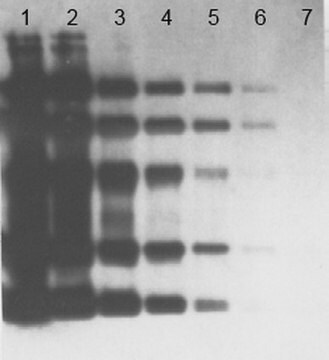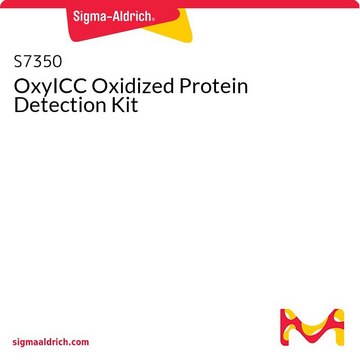S7450-M
OxyIHC Oxidative Stress Detection Kit
The OxyIHC Oxidative Stress Detection Kit contains the chemical & immunological reagents necessary to detect protein oxidation in various tissues from a variety of organs & animal species.
別名:
Oxidative Stress Assay Kit
About This Item
おすすめの製品
詳細
apoptosis, aging, neurodegenerative diseases, chronic inflammatory diseases, pulmonary diseases, and
cardiovascular diseases (for reviews, see ref. 1-4). Living organisms are continually exposed to potentially
harmful oxygen free radicals that are generated thru normal cellular functions as well as from environmental
factors (1, 5-7). Yet, these reactive molecules are mitigated by the presence of antioxidants and therefore
organisms exist with a delicate balance between oxidants and antioxidants (7-9). During times of oxidative
stress there is an imbalance in favor of the oxidants. The end result of which is that free radicals are able to
attack and modify sub-cellular components including nucleic acids, lipids and proteins (7, 10-12).
Proteins are one of the major targets of reactive species. Oxidation of proteins modifies the side chains of
methionine, histidine, and tyrosine and forms cysteine disulfide bonds (16-19). Metal catalyzed oxidation of
proteins introduces carbonyl groups (aldehydes and ketones) at lysine, arginine, proline or threonine
residues in a site-specific manner (16, 20-22). The oxidative modification of proteins can modulate
biochemical characteristics of proteins such as enzymatic activity (21-23), DNA binding activities of
transcription factors (24-26), and the susceptibility to proteolytic degradation (12, 25-28). While a
relationship between protein oxidation and aging has been suggested (29-31), little is known about the
importance of oxidative modification of individual proteins in the pathophysiology of free radical mediated
processes. Not surprisingly, carbonyl modification of proteins has become a key biomarker for the
identification of oxidative stress.
necessary to detect protein oxidation in various tissues from a variety of organs and animal species. The
OxyIHC test method involves chemical derivatization of protein carbonyl groups with 2,4-
dinitrophenylhydrazine (DNPH). This chemical reaction results in proteins being covalently coupled to DNP
at their carbonyl sites. The DNP-derivatized proteins are then detected using an antibody that specifically
binds to the DNP moiety. Subsequent incubation with biotin conjugated secondary antibody, streptavidin
conjugated HRP, and development using a 3,3’ diaminobenzidine (DAB) staining allows
immunohistochemical detection of protein oxidation.
アプリケーション
アポトーシス及び癌
ニューロサイエンス
神経変性疾患
老化
構成
10X Antigen Retrieval Buffer, One 1.25 mL bottle
5X Blocking Buffer, One 2.5 mL bottle
Primary Antibody, One 125 mL vial
DAB-A, One 500 mL vial
DAB-B, One 12 mL bottle
Antibody Diluent, One ready to use 12.5 mL bottle
Biotinylated Secondary Antibody, One ready to use 12.5 mL bottle
Streptavidin conjugated HRP, One ready to use 12.5 mL bottle
Hematoxylin, One ready to use 12.5 mL bottle
DNPH Solution, One ready to use 12.5 mL bottle
Derivatization Control Solution, One ready to use 12.5 mL bottle
保管および安定性
date of receipt if stored and handled properly.
免責事項
シグナルワード
Danger
危険有害性の分類
Acute Tox. 4 Oral - Aquatic Chronic 2 - Carc. 1B - Eye Irrit. 2 - Met. Corr. 1 - Muta. 2 - Skin Irrit. 2 - Skin Sens. 1 - STOT RE 2 Oral
ターゲットの組織
Kidney
保管分類コード
6.1D - Non-combustible, acute toxic Cat.3 / toxic hazardous materials or hazardous materials causing chronic effects
WGK
WGK 3
引火点(°F)
Not applicable
引火点(℃)
Not applicable
適用法令
試験研究用途を考慮した関連法令を主に挙げております。化学物質以外については、一部の情報のみ提供しています。 製品を安全かつ合法的に使用することは、使用者の義務です。最新情報により修正される場合があります。WEBの反映には時間を要することがあるため、適宜SDSをご参照ください。
毒物及び劇物取締法
キットコンポーネントの情報を参照してください
PRTR
キットコンポーネントの情報を参照してください
消防法
キットコンポーネントの情報を参照してください
労働安全衛生法名称等を表示すべき危険物及び有害物
キットコンポーネントの情報を参照してください
労働安全衛生法名称等を通知すべき危険物及び有害物
キットコンポーネントの情報を参照してください
カルタヘナ法
キットコンポーネントの情報を参照してください
Jan Code
キットコンポーネントの情報を参照してください
試験成績書(COA)
製品のロット番号・バッチ番号を入力して、試験成績書(COA) を検索できます。ロット番号・バッチ番号は、製品ラベルに「Lot」または「Batch」に続いて記載されています。
ライフサイエンス、有機合成、材料科学、クロマトグラフィー、分析など、あらゆる分野の研究に経験のあるメンバーがおります。.
製品に関するお問い合わせはこちら(テクニカルサービス)





